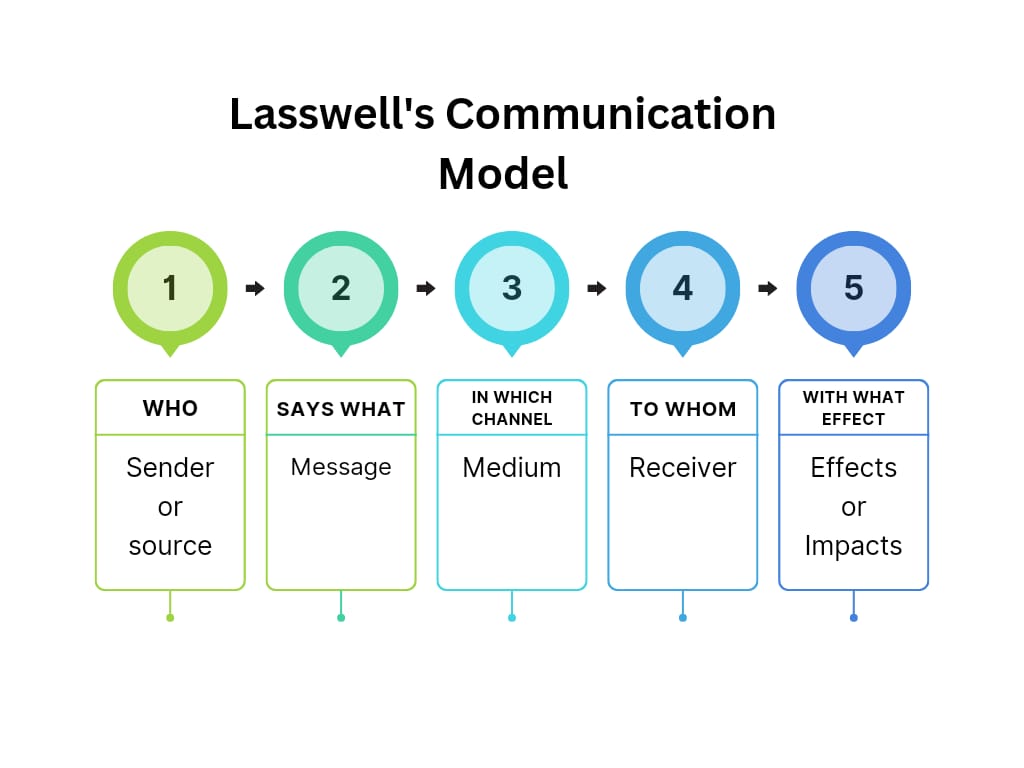Lasswell's Communication Model.
The Lasswell communication model is a classic communication model developed by Harold D. Lasswell in 1948. It focuses on the elements and functions of communication and is often summarized with the following questions: Who? Says What? In Which Channel? To Whom? With What Effect?
COMMUNICATION
11/1/20233 min read


Lasswell's Communication Model.
The Lasswell's Communication Model, developed by communication theorist Harold Lasswell, is a simple framework that helps explain the elements of communication process.
Five Questions about the Communication Process
Lasswell's model focuses on answering five key questions about the communication process:
1. Who:
This refers to the sender or source of the communication. Who is sending the message?
2. Says What:
What is the content of the message being communicated? What is the information or message that the sender is trying to convey?
3. In Which Channel:
This pertains to the medium or channel through which the message is being transmitted. It could be spoken, written, or through various media channels.
4. To Whom:
Who is the intended audience or receiver of the message? To whom is the message directed?
5. With What Effect:
This question addresses the impact or effect of the communication on the receiver. What is the desired or actual outcome of the message?
The Lasswell model provides a framework for analyzing and understanding the basic components of communication, and it is often used in communication studies and research to break down and examine the different aspects of the communication process.
Critical Analysis of Lasswell's Communication Model:
Here's a critical analysis of this model:
Oversimplification:
One of the main criticisms of the Lasswell Model is its oversimplification of the complex communication process. It reduces communication to a series of basic questions without considering the intricate dynamics, context, and feedback that are essential in real-life communication situations. In reality, communication is much more nuanced and multidimensional.
Lack of Feedback:
The model does not explicitly include feedback as a component. Effective communication often involves a feedback loop where the sender receives a response from the receiver, leading to adjustments in the message or the communication process. Ignoring this aspect can limit our understanding of how communication works.
Context:
The model doesn't adequately account for the role of context in communication. In real-life situations, the context, including cultural, social, and environmental factors, plays a significant role in how a message is received and interpreted. The Lasswell Model fails to acknowledge the importance of context in the communication process.
Linearity:
The model presents communication as a linear process with a clear sequence of events. In contrast, modern communication theories, such as the Shannon-Weaver model and the transactional model of communication, emphasize that communication is a dynamic and interactive process. People engage in simultaneous encoding and decoding, and the process is ongoing rather than strictly linear.
Simplistic View of Communication Effects:
The model's "With What Effect" component is overly simplistic in its portrayal of the outcomes of communication. In reality, the effects of communication can be diverse and multifaceted, including persuasion, attitude change, information sharing, and more. The model does not delve into the complexity of these effects.
Cultural and Societal Bias:
The model does not address cultural and societal differences, which are critical in understanding the effectiveness and interpretation of communication. Communication is heavily influenced by cultural norms and values, and this model overlooks the cultural dimension of communication.
Technology and Media:
The model was developed at a time when mass communication was primarily through traditional media like newspapers and radio. It doesn't account for the impact of modern technology and digital media on communication. Today, communication occurs through various platforms, and these new channels have reshaped the communication landscape significantly.
In summary, while the Lasswell Communication Model provides a basic framework for thinking about communication process, it is criticized for its oversimplification, lack of consideration for feedback and context, linearity, and a failure to address cultural and technological factors. It is important to recognize that this model is a starting point for understanding communication but falls short in capturing the complexity and dynamics of real-world communication processes. More modern and comprehensive models have since been developed to better represent the intricacies of human communication.
© 2025 Copyright Amna Sadaf
